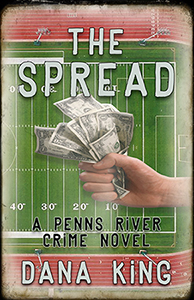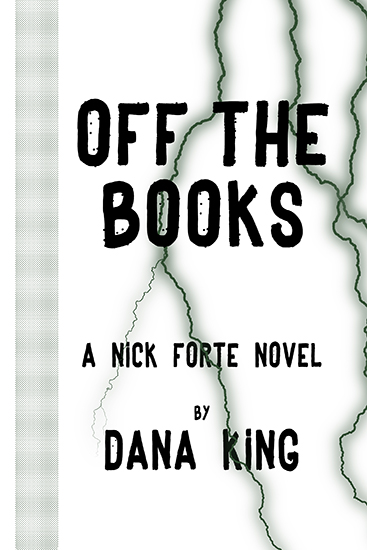I met Colin Conway at Bouchercon in Dallas and liked him
right away. (Of course he was standing right next to Frank Zafiro, so the bar
was pretty low, but still.) I was aware of Colin’s work from having read, and
loved, Charlie
3-16, which he wrote in collaboration with Frank. We got to discussing
Colin’s current solo project, Cozy
up to Death, the first book in a
series that would fit the description of a cozy—bookstore in a small seaside
town, bookstore cat, bookstore owner solves crimes—except that the main
character is a biker in the Witness Protection Program. That hooked me right
there and I asked him to talk about it on the blog.
Besides writing the Cozy
Up series, Colin is the author of the 509 Crime Stories, a series of novels
set in Eastern Washington with revolving lead characters. They are standalone
tales and can be read in any order.
He is also the co-author of The Charlie-316 series. The
first book in the series, Charlie-3-16,
is a political/crime thriller and has been described as “riveting and
compulsively readable,” “the real deal,” and “the ultimate ride-along.”
Colin served in the U.S. Army and later was an officer of
the Spokane Police Department. He's a commercial real estate broker/investor,
owned a laundromat, invested in a bar, and ran a karate school. (If all of
these gigs in conjunction don’t sound like fronts, I don’t know what does.)
He lives with his beautiful life partner, their three
wonderful children, and a crazy, codependent Vizsla that rules their world.
Find out more about Colin at his official website—colinconway.com.
One Bite at a Time:
Hi, Colin. Good to see you back on OBAAT. You were here last with Frank Zafiro
to talk about Charlie-316 but Cozy Up to Death is a solo venture for
you. Start us off by giving just a tease of the story.
Colin Conway: I’ve looked for catchy ways to describe the book and
I have a couple. The first is the back copy of the book. “A man in hiding. A
gang of outlaws searching for retribution. This is no time for cupcakes.”
This second is a blurb from Libby
Klein, the author of the Poppy McAllister mysteries, who said, “This is not
your grandma’s cozy.”
OBAAT: Cozy up to Death has all the hallmarks
of a cozy: The protagonist runs a bookstore, the bookstore has a cat, it’s in a
small waterfront town in Maine, there’s a chaste love interest, and a quirky
group of characters. The things that happen day to day are appropriate. Yet the
“store owner” is an ex-biker on the lam and the prospect of violence is there
almost all the time. It’s a trick path to walk and you did it quite well. What
gave you the idea to mess with the cozy structure?
 CC: The idea came
to me while attending Left Coast Crime (LCC), a writer’s conference. My
girlfriend had batted around her own cozy concept for several years and,
because of that, I thought it would be helpful to attend one of the LCC sessions
on that genre.
CC: The idea came
to me while attending Left Coast Crime (LCC), a writer’s conference. My
girlfriend had batted around her own cozy concept for several years and,
because of that, I thought it would be helpful to attend one of the LCC sessions
on that genre.
There are certain rules when writing cozies—limited (or no)
violence, limited (or no) sexy stuff, and limited (or no) swearing. The genre also has certain tropes. Among them are small towns, charming protagonists
who work in cute businesses, and often an adorable pet.
None of that sounded like anything I would ever write. However,
being a writer who doesn’t like being told what to do, I thought, “What if I wrote
a cozy? How would that look?”
That’s when I came up with the idea of an anti-cozy
cozy. Basically, my protagonist would be
a big, tattooed guy who is an informant for the FBI. Because of his physical attributes, he would be
hard to hide. If I dropped him into any
type of Murder, She Wrote scenario, he’d wreak havoc, even if it was
unintentional.
OBAAT: Beau
Smith—sorry, Brody Steele is in Witness Protection. You had to fudge a few
things about how the program is run to fit the demands of a cozy structure, but
never in a way that even I, a notorious prick when it comes to verisimilitude,
objected. On one hand, that a sign of an author who knows the material so well
he understands what can be messed with before the shark gets jumped. That said,
did it ever give you pause while you writing to think, “They’d never do this…ah
what the hell.”
CC: Even in a
cozy, verisimilitude should be important. Several things I chose to do came
from some sliver of truth. In fact, a Popular Mechanics article, How
the Witness Protection Program Decides Where to Send People, helped
spark the whole plan for the series.
In the article, a retired FBI agent explains that his agency
had businesses they used for agent cover stories. It’s a procedure called “backstopping.” This agent opined that the U.S. Marshals probably
had similar business for those in witness protection.
I thought what if they actually put witnesses to work inside
those businesses instead of just using them for backstories?
There was one convention I created in my story—a website
tracking mob informants—that I have often thought, “Why doesn’t something like
it exist?” It seemed like a natural
thing to create especially with so many people in hiding. After I put it on the page, I’ve had numerous
people say, “Does something like that really exist?” When I tell them I don’t
think so, they usually respond, “Why the heck not?”
OBAAT: You were a
cop and even though Cozy Up to Death
is not a procedural, are there any things in the book based on your actual
experience?
CC: Nothing based
on law enforcement experience made it into the book. Beau is an amateur sleuth who
previously solved all his problems in the motorcycle club by force. Now, he’s trying to use his head which
creates its own set of issues.
Beyond being a mystery, Cozy Up to Death is a
fish-out-of-water story. Think Crocodile Dundee, if you will. We’ve all been that fish at some point in our
life. For this story (and its sequels),
I’ve ramped up that feeling of being out of step with everyone around.
OBAAT: The style
and genre of Cozy Up to Death is far
removed from Charlie-316; your range
impresses me. Is there anything different in how you approach the different
books either in your writing method or frame of mind?
CC: Thank you for
the compliment. I really appreciate it.
The most important thing about writing the two different
series was my audience. I wrote Cozy
Up to Death for my mother-in-law.
She is a deeply religious person who has read my other works. Violence and swearing in books like Charlie-316
bothers her, but she still wants to be supportive.
So when I first started CUTD, I kept thinking, “Can she show
this part to her friends at church?”
Once I got into that groove, the book flowed easily along.
With that being said, the story is for anyone who digs
traditional crime fiction or mysteries. Especially since I push the bounds of
the genre in the arena of violence.
I’m willing to bet that no cozy has ever featured a full-on donnybrook
inside a bookstore with a protagonist using a hardback as his weapon of choice.
OBAAT: This is an
awkward question but we all know publishers are in the business of putting out
books that they can shoehorn into a known market. Cozy up to Death plays with the cozy genre to the point where I can
imagine a cautious editor deciding it’s neither fish nor fowl and take a pass.
Did you run into any of that on the road to publication?
CC: Not awkward
at all. I decided early on I was going
to publish this through my own company. Publishing
is a different game now. As Mark
Dawson’s Self-Publishing Show says as part of their intro, “There’s never been
a better time to be a writer.” Some of
my work goes through a publisher while some of it is being independently handled.
I choose to go the indie route with the Cozy Up series due
to how quickly I wanted the books to follow each other. I waited to launch the first book until I had
three of them written and ready to go. That way they could all come out shortly
after the previous one.
Any reader will tell you the worst part of a new series is
the wait for the next book. I will
launch the first three books of the series in roughly ninety days. That is unheard of in traditional publishing.
OBAAT: Tell us a
little about your 509 stories.
CC: The 509 Crime
Stories are set in eastern Washington state and feature stories with
alternating viewpoints. The novels are centered
around the Spokane Police department, but the lead characters change with each
story. Due to the alternating points-of-view, I’m able to not only tell
different stories, but deal with different issues.
For example, in the first book, The Side Hustle, a
detective (Quinn Delaney) is struggling through overwhelming personal
debt. He’s got collectors after him and
he’s received a notice of foreclosure on his home. It’s something I’ve never read in a crime
fiction book, and I thought it would be interesting to read how that impacts a Major
Crimes detective during an investigation.
In the second novel, The Long Cold Winter, our hero
(Dallas Nash) is depressed following the recent death of his wife. As such, he’s begun hearing music every
morning and is struggling to understand if his wife is sending him messages
from beyond the grave. This leads him to wonder if he might be crazy.
Both characters are in the other’s story albeit as minor
players. That’s how the series continues
as we see the characters grow and change not only through their own eyes, but
also through the actions and opinions of those around them.
Everybody is the hero of their own story—even a dirty cop
(whose tale is coming soon).
OBAAT: Classic
last question: What are you working on now?
CC: It’s going to be a busy 2020. As I mentioned above, the second and third
novels in the Cozy Up series will be released in early spring (Cozy Up to
Murder and Cozy Up to Blood).
Beau will be on the move in both those books. Unfortunately for the big man (but great for
the reader), he’s going to have a tough time fitting in anywhere.
I’ve got the next several Cozy Up stories mapped out, so
I’ll get to writing them in late spring.
Beyond the cozy genre, the final three books for the Charlie-316
series will be released this year from Down & Out Books. This starts in late June with Never the
Crime. Frank Zafiro and I had
written the final three books and petitioned D&O to release them all this
year (the previous plan was one a year).
They graciously agreed so book three will be out in September and book
four will drop in November.
There are a couple 509 works that are done and sitting in
the editing queue. Once those get
cleaned up and approved, I’ll figure out what to do with them.




No comments:
Post a Comment